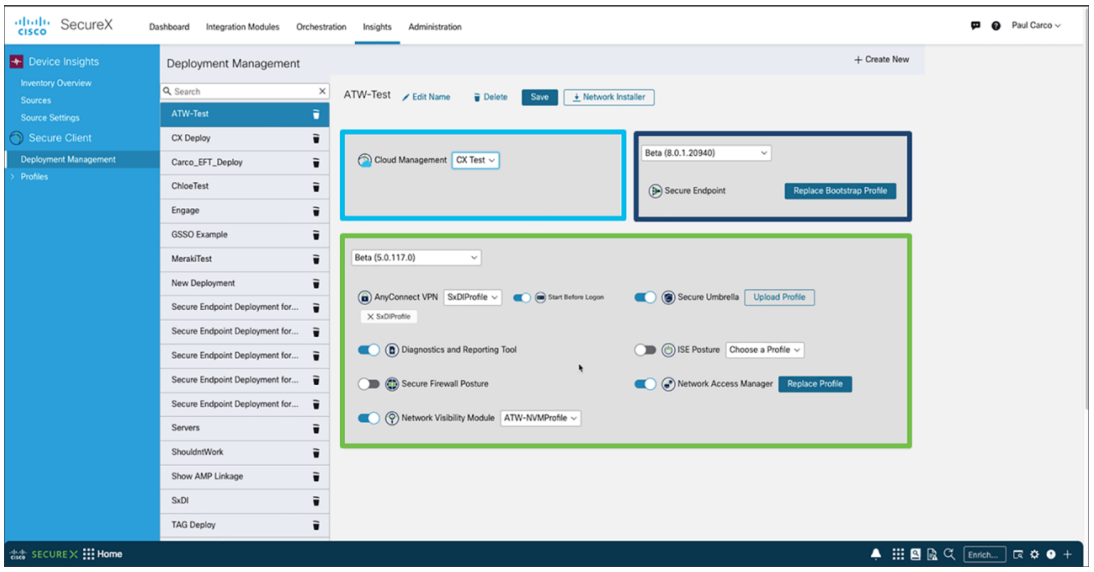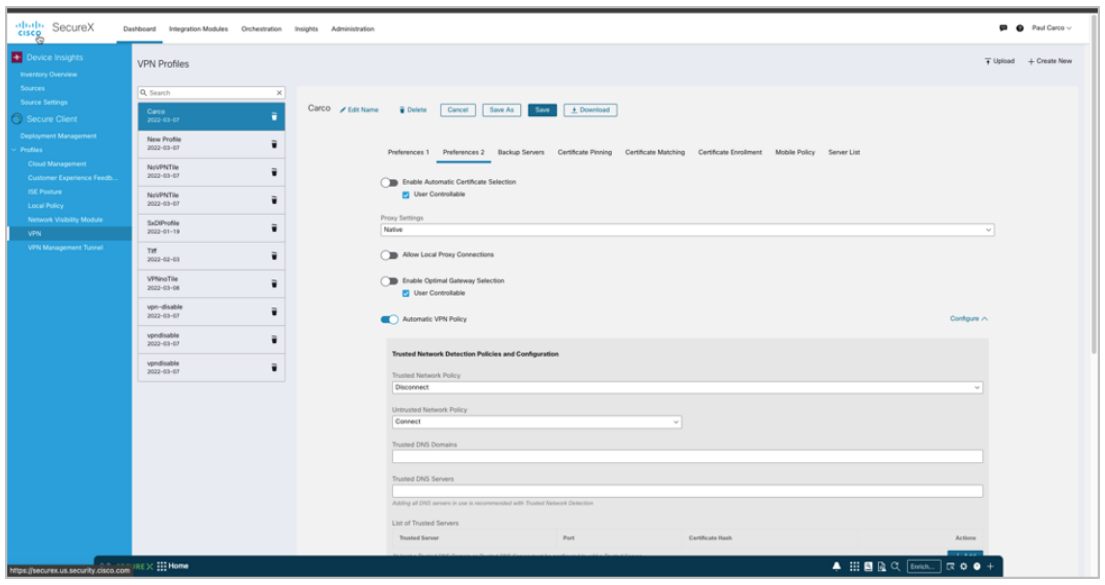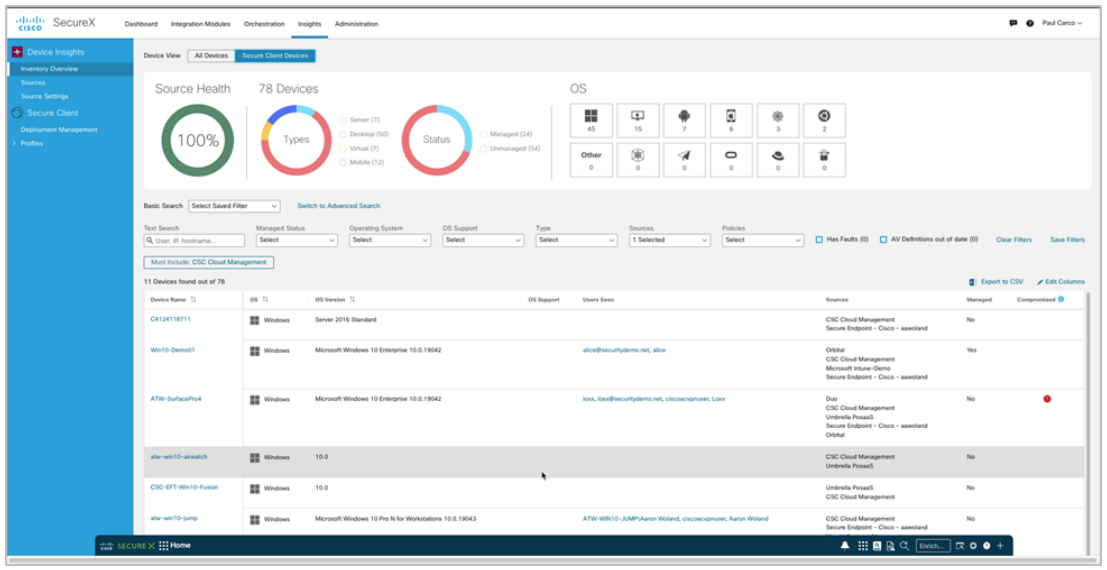
Cisco Secure Client (including AnyConnect)
Unify your agents and improve your ability to simplify, manage, and deploy your endpoint agents
Secure access is just the beginning
Your teams need hassle-free access to corporate resources and private apps. You need to keep your business safe. Cisco Secure Access makes it happen.
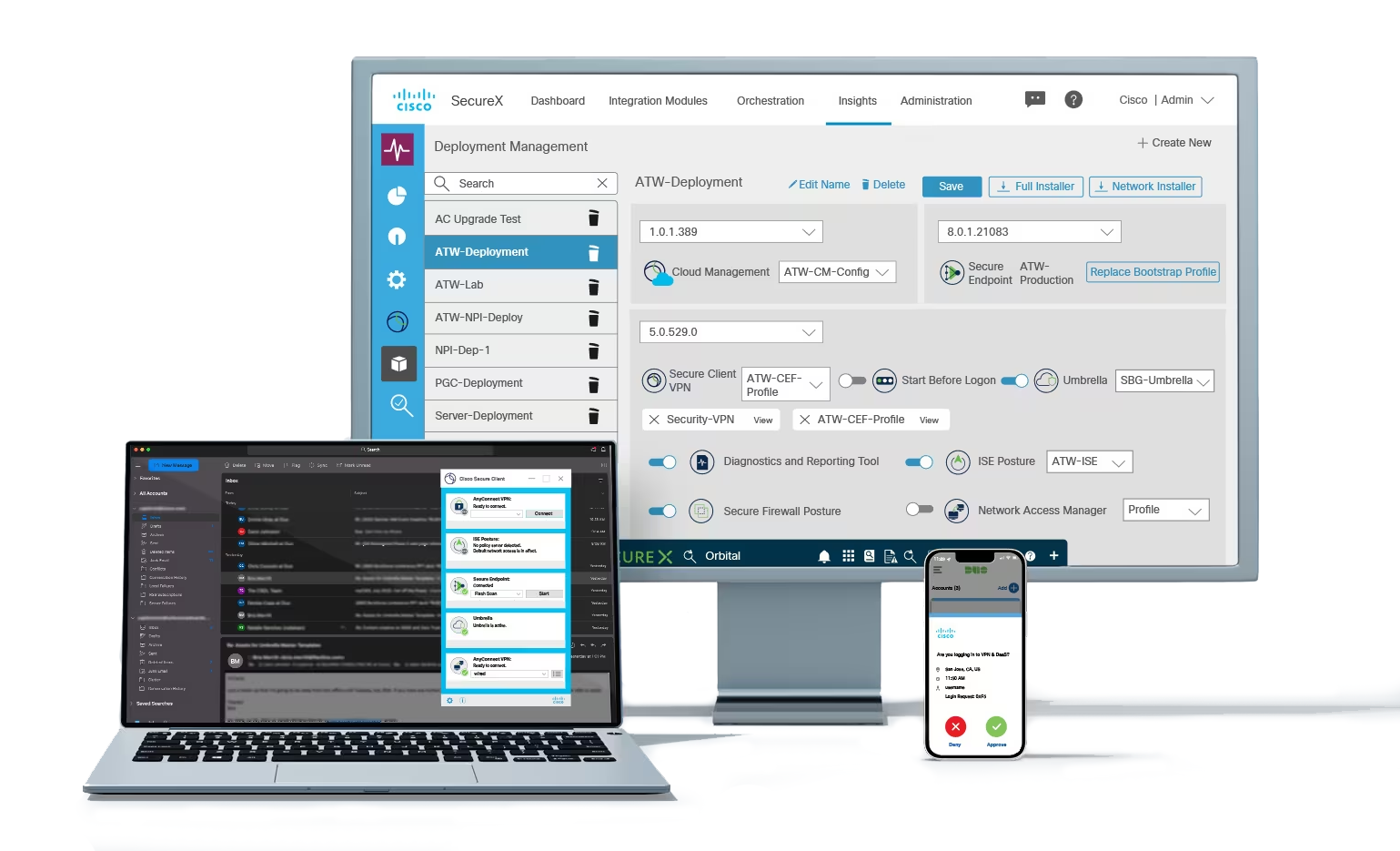
Manage and deploy multiple endpoint security agents
Secure Client harnesses the powerful industry-leading AnyConnect VPN/ZTNA and helps IT and security professionals manage dynamic and scalable endpoint security agents in a unified view.
Comprehensive endpoint security
Reduce your clients and enjoy advanced endpoint protection across control points within Secure Client.
An intelligent VPN that's never off duty
You achieve security compliance, and your users get to connect to your VPN quickly and easily. It's a win-win.
Unified cloud management
See all your security agents on one screen with Secure Client's single-cloud management console.
Greater network visibility
Monitor endpoint application usage and user behavior when coupled with Cisco Secure Network Analytics.
Perfect pairing

Cisco SecureX capabilities
Deploy, update, and manage Cisco Secure endpoint agents with SecureX Device Insights.

Cisco Secure Endpoint module
With advanced endpoint protection across control points, your business is safer from threats, and more resilient.

Cisco Umbrella Roaming module
Cloud-delivered security from Cisco Secure Client protects your users even when they're off the VPN.
What is a security client
Watch this video to learn more about Secure Client (including AnyConnect).
Overview:
Cisco Secure Client, formerly Cisco AnyConnect Secure Mobility Client, is available for Windows 10 and 11. The user interface will be familiar to current AnyConnect users with some updated branding and iconography.
Customers running on macOS and Linux will continue to utilize AnyConnect 4.x until Cisco Secure Client has full OS support
Cisco Secure Client vs AnyConnect

Cisco Secure Client is the latest version of one of the most widely deployed security clients. Secure Client is built upon Cisco AnyConnect, which provides Remote Access services and a suite of modular security services.
Important to know:
AnyConnect is now known as Cisco Secure Client. Additionally, Secure Endpoint is a new optional module of Secure Client that provides customers with integrated advanced Endpoint Detection and Response (EDR) and Extended Detection and Response (XDR) capabilities.
New users can install Secure Client by traditional methods and customers looking to adopt the new Cloud Management functions can do so with a packaged installer download from the Secure Endpoint portal.
Cloud Management via SecureX with Device Insights is a new optional capability for Secure Client. This new feature makes deploying, configuring, and monitoring Secure Client simple. Customers are not required to adopt cloud management and can continue to deploy using the current mechanisms; Cisco Secure Firewall, ISE, Software Management tools, i.e., SCCM as an example, or directly using the MSI.
New SecureX screens and tools for Cloud Management include:
- Customizing and generating a network installer for Secure Client
- Creating and downloading custom VPN profiles for Secure Client
- Integrating with Device Insights to monitor and manage an inventory of endpoints with Secure Client installed
Modules and Features:
AnyConnect VPN/ZTNA User and Management Tunnels
Cisco Secure Client provides many options for automatically connecting, reconnecting, or disconnecting VPN sessions. These options offer a convenient way for your users to connect to your VPN and support your network security requirements. An always-on intelligent VPN helps AnyConnect client devices automatically select the optimal network access point and adapt its tunneling protocol to the most efficient method, including Datagram Transport Layer Security (DTLS) protocol for latency-sensitive traffic, and a path for entering Zero Trust Network Access. Tunneling support is also available for IP Security Internet Key Exchange version 2 (IPsec IKEv2). Select application VPN access may be enforced on Apple iOS and Google Android.
Management VPN tunnel provides connectivity to the corporate network whenever the client system is powered up, not just when the end-user establishes a VPN connection. As a result, you can perform patch management on out-of-the-office endpoints, especially devices that are infrequently connected by the user, via VPN, to the office network. This feature will also benefit endpoint OS login scripts that require corporate network connectivity. This capability does not have an end-user interface.
Cisco Secure Endpoint
Available with Cisco Secure Client for Windows, Secure Endpoint functions as a module within Cisco Secure Client and is accessible via the Cisco Secure Client user interface. The Cisco Secure Endpoint Cloud can also deploy Cisco Secure Client with Cisco Secure Endpoint, as can SecureX Cloud Management. by taking advantage of this integration, customers can reduce the number of clients under their management.
Cloud Management Module
SecureX Cloud Management Deployment for Cisco Secure Client enables administrators to create cloud-managed deployments of Cisco Secure Client. The deployment configuration generates the option to download a lightweight bootstrapper that contains the information needed by the endpoint to contact the cloud for the specified Cisco Secure Client modules by the deployment with their associated profiles. A full installer is also available. In either case, the installers can be distributed to the endpoints by the administrator using their preferred software method.
Network Visibility Module
The Network Visibility Module delivers a continuous feed of high-value endpoint telemetry, which allows organizations to see endpoint and user behaviors on their networks. It collects flow from endpoints on and off-premises and valuable contexts like users, applications, devices, locations, and destinations. It caches this data and sends it to the Network Visibility Module Collector when it is on a trusted network (the corporate network on-prem or through VPN). Network Visibility Module Collector is a server that receives Internet Protocol Flow Information Export (IPFIX) data and optional filters that are exported to Cisco Secure Network Analytics Endpoint License, Syslog, or a third-party collector. Network Visibility Module Collector processes received messages that adhere to the nvzFlow protocol specification.
NVM sends flow information only when it is on the trusted network. By default, no data is collected. Data is collected only when configured as such in the profile, and the data continues to be collected when the endpoint is connected. If collection is done on an untrusted network, it is cached and sent when the endpoint is on a trusted network. No UI
Umbrella Roaming Security module
To take advantage of Umbrella Roaming Security service, you need the Professional, Insights, Platform, or MSP package subscriptions. Umbrella Roaming Security provides DNS-layer security when no VPN is active and adds an Intelligent Proxy. Additionally, Cisco Umbrella subscriptions provide content filtering, multiple policies, robust reporting, functional directory integration, and more. Use the same Umbrella Roaming Security module regardless of the subscription.
ISE Posture module
ISE Posture is a module you can choose to install as an additional security component of the Cisco Secure Client product. Perform an endpoint posture assessment on any endpoint that fails to satisfy all mandatory requirements and is deemed non-compliant. The other endpoint authorization states are posture unknown or compliant by meeting mandatory requirements. The client receives the posture requirement policy from the headend, collects the posture data, compares the results against the policy, and sends the assessment results back to the headend. Even though ISE determines whether the endpoint is compliant, it relies on Secure Endpoint's policy evaluation.
Network Access Manager
Network Access Manager manages user and device identity and the network access protocols required for secure access. It works intelligently to prevent end-users from making connections that violate administrator-defined policies. It detects and selects the optimal Layer 2 access network by its policies and performs device authentication for access to both wired and wireless networks.
Posture (for Secure Firewall)
Secure Firewall Posture performs server-side evaluation where the Secure Firewall asks only for a list of endpoint attributes such as operating system, IP address, registry entries, local certificates, and filenames, and they are returned by Secure Firewall Posture. Based on the policy's evaluation result, you can control which hosts are allowed to create a remote access connection to the security appliance.
| Features | Benefits and Details |
|---|---|
| Remote-Access VPN/ZTNA | |
Broad operating system support |
Windows 11 (64-bit), current Microsoft supported versions of Windows 10 x86 (32-bit) and x64 (64-bit), and Windows 8 Microsoft-supported versions of Windows 11 for ARM64-based Microsoft-supported versions of Windows 10 for ARM64-based PCs Note:Cisco Secure Client 5.0 is Windows 10/11 Only. AnyConnect supports all the above. macOS 12, 11.2, 10.15, and 10.14 (all 64-bit) Red Hat Ubuntu SUSE (SLES) See mobile data sheet for Mobile OS support |
Software access |
Downloads are available in the cisco.co.il Software Center Technical support and software entitlement for AnyConnect is included with all term-based Plus and Apex licenses, and it can be purchased separately for the Plus perpetual license The contract number must be linked to cisco.co.il ID |
Optimized network access: VPN protocol choice SSL (TLS and DTLS); IPsec IKEv2 |
AnyConnect provides a choice of VPN protocols, so administrators can use whichever protocol best fits their business needs Tunneling support includes SSL (TLS 1.2 and DTLS 1.2) and next-generation IPsec IKEv2 DTLS provides an optimized connection for latency-sensitive traffic, such as VoIP traffic or TCP-based application access TLS 1.2 (HTTP over TLS or SSL) helps ensure availability of network connectivity through locked-down environments, including those using web proxy servers IPsec IKEv2 provides an optimized connection for latency-sensitive traffic when security policies require use of IPsec |
Optimal gateway selection |
Determines and establishes connectivity to the optimal network-access point, eliminating the need for end users to determine the nearest location |
Mobility friendly |
Designed for mobile users Can be configured so that the VPN connection remains established during IP address changes, loss of connectivity, or hibernation or standby With Trusted Network Detection, the VPN connection can automatically disconnect when an end user is in the office and connect when a user is at a remote location |
Encryption |
TLS/DTLS 1.2 strong ciphers supported Next-generation encryption, including NSA Suite B algorithms, ESPv3 with IKEv2, 4096-bit RSA keys, Diffie-Hellman group 24, and enhanced SHA2 (SHA-256 and SHA-384). Applies only to IPsec IKEv2 connections. Premier (formerly AnyConnect Apex) is required |
Wide range of deployment options |
Deployment options: Predeploy—New installations and upgrades are done either by the end user or by using an enterprise Software Management System (SMS) Web Deploy—The Cisco Secure Client package is loaded on the headend, which is either a Secure Firewall ASA, Secure Firewall Threat Defense, or an ISE server. When the user connects to a firewall or to ISE, Cisco Secure Client is deployed to the client SecureX Cloud Management Deployment— Cisco Secure Client 5.0 can be deployed from the Cloud using customizable deployments |
Wide range of authentication options |
Protocols: SAML 2.0 with Embedded or Native Browser (SSO) RADIUS LDAP Certificate. TACACS+ HTTP Form SDI Kerberos Headend Methods AAA AAA and Certificate Certificate Only SAML Multiple Certificates and AAA |
Consistent user experience |
Full-tunnel client mode supports remote-access users requiring a consistent LAN-like user experience Multiple delivery methods help ensure broad compatibility of AnyConnect User may defer client software updates if configured by the Administrator Customer experience feedback option is available |
Centralized policy control and management |
Policies can be preconfigured or configured locally and can be automatically updated from the VPN security gateway API for AnyConnect eases deployments through webpages or applications Checking and user warnings are issued for untrusted certificates Cisco Secure Client supports deployment and management using the SecureX platform |
Advanced IP network connectivity |
Public connectivity to and from IPv4 and IPv6 networks Access to internal IPv4 and IPv6 network resources Administrator-controlled split-tunneling (Network and Dynamic (domain) and full tunnel network access policy Access control policy using Dynamic Access Polices or the identity Services Engine Per-app VPN policy for Apple iOS and Google Android IP address assignment mechanisms: Static Internal pool Dynamic Host Configuration Protocol (DHCP) RADIUS/Lightweight Directory Access Protocol (LDAP) |
Robust unified endpoint compliance (Premier formerly Apex license required) |
Endpoint posture assessment and remediation is supported for wired and wireless environments (replacing the Cisco Identity Services Engine NAC Agent). Requires Identity Services Engine (ISE) 1.3 or later with Identity Services Engine Apex license ISE Posture (working in conjunction with ISE) and Host Scan (VPN only) seeks to detect the presence of anti-malware software, Windows service packs/patching state, and range of other software services on the endpoint system prior to granting network access Administrators also have the option of defining custom posture checks based on the presence of running processes ISE Posture and Host Scan can detect the presence of a watermark on a remote system. The watermark can be used to identify assets that are corporate owned and provide differentiated access as a result. The watermark-checking capability includes system registry values, file existence matching a required CRC32 checksum, and a range of other capabilities. Additional capabilities are supported for out-of-compliance applications |
Client firewall policy |
Provides added protection for split-tunneling configurations Used in conjunction with the AnyConnect and Cisco Secure Client to allow for local-access exceptions (for example, printing, tethered device support, and so on) Supports port-based rules for IPv4 and network and IP Access Control Lists (ACLs) for IPv6 Available for Windows and Mac OS X platforms |
Localization |
In addition to English, the following language translations are included: cs-CZ Czech (Czech Republic) de-DE German (Germany) es-ES Spanish (Spain) fr-CA French (Canada) fr-FR French (France) hu-HU Hungarian (Hungary) it-IT Italian (Italy) ja-JP Japanese (Japan) ko-KR Korean (Korea) nl-NL Dutch (Netherlands) pl-PL Polish (Poland) pt-BR Portuguese (Brazil) ru-RU Russian (Russia) zh-CN Chinese (China) zh-HANS Chinese (Simplified) zh-HANT Chinese (Traditional) zh-TW Chinese (Taiwan) |
Ease of client administration |
Administrators can automatically distribute software and policy updates from the headend security appliance thereby eliminating administration associated with client software updates. Cisco Secure Client 5.0 also offers administrators the ability to deploy and manage the client from the SecureX Cloud. Administrators can determine which capabilities to make available for end-user configuration Administrators can trigger an endpoint script at connect and disconnect times when domain login scripts cannot be utilized Administrators can fully customize and localize end-user visible messages |
Profile editor |
AnyConnect policies may be customized directly from Cisco Adaptive Security Device Manager (ASDM) Stand-alone Profile Editor SecureX Cisco Secure Client Profile page |
Diagnostics |
On-device statistics and logging information are available Logs can be viewed on device Logs can be easily emailed to Cisco or an administrator for analysis |
Federal Information Processing Standard (FIPS) |
FIPS 140-2 level 2 compliant (platform, feature, and version restrictions apply) |
| Secure Mobility and Network Visibility | |
Cisco Umbrella Roaming (Cisco Umbrella Roaming license required) |
The Umbrella Roaming Security module requires a subscription to a Umbrella Roaming Security service with either the Professional, Insights, Platform, or MSP package. Umbrella Roaming Security provides DNS-layer security when no VPN is active, and a Cisco Umbrella subscription adds Intelligent Proxy. Additionally, Cisco Umbrella subscriptions provide content filtering, multiple policies, robust reporting, active directory integration, and much more. The same Umbrella Roaming Security module is used regardless of the subscription.
Utilize endpoint redirection to enforce DNS-based security when the VPN is off or with split tunnels (applies to communication outside tunnel). |
Network Visibility module (Premier formerly Apex license required) |
Capture endpoints flows with rich user, endpoint, application, location, and destination context Flexible collection settings on and off premise Uncover potential behavior anomalies by monitoring application usage Allows for more informed network-design decisions Usage data can be shared with NetFlow analysis tools such as Cisco Network Analytics |
Cisco Secure Endpoint formerly Advanced Malware Protection (AMP) for Endpoints (Cisco Secure Endpoints licensed separately) |
Cisco Secure Client brings together both AnyConnect VPN/ZTNA and Cisco Secure Endpoint capabilities Extends endpoint threat services to remote endpoints, increasing endpoint threat coverage Provides more proactive protection to further assure an attack is mitigated at the remote endpoint quickly macOS endpoints can continue to use standalone Secure Endpoint client |
| Network Access Manager and 802.1X | |
Media support |
|
Network authentication |
|
Extensible Authentication Protocol (EAP) methods |
|
Wireless encryption methods (requires corresponding 802.11 NIC support) |
|
Wireless encryption protocols |
Counter mode with Cipher Block Chaining Message Authentication Code Protocol (CCMP) using the Advanced Encryption Standard (AES) algorithm |
Session resumption |
RFC2716 (EAP-TLS) session resumption using EAP-TLS, EAP-FAST, EAP-PEAP, and EAP-TTLS EAP-FAST stateless session resumption |
Ethernet encryption |
Media Access Control: IEEE 802.1AE (MACsec) Key management: MACsec Key Agreement (MKA) Defines a security infrastructure on a wired Ethernet network to provide data confidentiality, data integrity, and authentication of data origin Safeguards communication between trusted components of the network |
One connection at a time (Windows only with Network Access Manager) |
Allows only a single connection to the network disconnecting all others No bridging between adapters Ethernet connections automatically take priority |
Complex server validation |
Supports “ends with” and “exact match” rules Support for more than 30 rules for servers with no name commonality |
EAP-Chaining (EAP-FASTv2) |
Differentiates access based on enterprise and non-enterprise assets Validates users and devices in a single EAP transaction |
Enterprise Connection Enforcement (ECE) |
Helps ensure that users connect only to the correct corporate network Prevents users from connecting to a third-party access point to surf the Internet while in the office Prevents users from establishing access to the guest network Eliminates cumbersome blocked listing |
Next-generation encryption (Suite B) |
Supports the latest cryptographic standards: Elliptic Curve Diffie-Hellman key exchange Elliptic Curve Digital Signature Algorithm (ECDSA) certificates |
Credential types |
|
Features and Benefits:
Investigation and response to cybersecurity incidents should not require more than 20 endpoint tools. Consolidating and simplifying security at the Endpoint is vital, but it becomes increasingly complex with every deployed security tool in your environment. Using multiple solutions can increase the time it takes for incident analysis and security system maintenance, not to mention that the learning curve is tremendous. It would help if you had a solution that takes the burden of managing and monitoring multiple endpoint applications. That's where Cisco Secure Client steps in.
Features and Benefits
Cisco Secure client is the next generation of AnyConnect. It enhances the modular approach of AnyConnect and introduces Cisco Secure Endpoint as a fully integrated module into the new Cisco Secure Client.
Existing customers will still enjoy a familiar and user-friendly experience. Existing Secure Endpoint (AMP for Endpoints) users will find the end user interface easy to navigate.
We are introducing the ability to deploy, update and manage Cisco Secure Client from the Cloud. This provides customers another deployment option to our long-existing deployment options; Pre-deploy (SCCM, MSI), Web Deploy with VPN Headends, Secure Firewall, and the Identity Services Engine. Cloud Management is an optional feature.
Cloud Management allows for different deployment installers that contain the modules and associated profiles that best fit the groups of users. The software will access the cloud transparently based on an administrative configuration in the CM profile. The user is no longer required to be on-premise either physically or via VPN to be updated.
Benefits For Security Administrators
- Low total cost of ownership from a single client providing multiple services
- Context-aware, comprehensive, and continuous endpoint security
- Extending flexible, policy-driven access to corporate resources across wired, wireless, and VPN.
Benefits For End Users
- Highly secure access across popular PC and mobile devices
- Consistent user experience
- Intelligent, dependable, and always-on connectivity
- Rebranded AnyConnect UI
- Unified Agent
- Cisco Secure Endpoint Module
- Cloud Managed option
- Pathway to Zero Trust Network Access
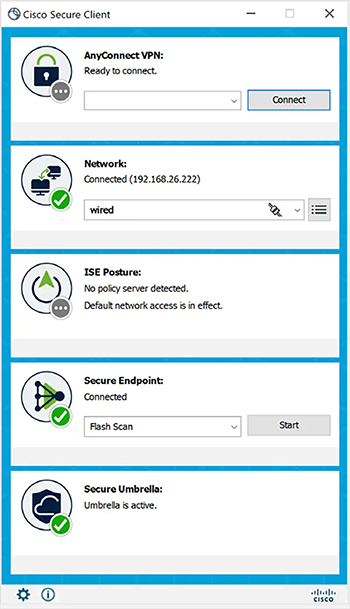
| Features | Description |
|---|---|
| AnyConnect VPN/ ZTNA User | Cisco Secure Client provides many options for automatically connecting, reconnecting, or disconnecting VPN sessions. These options offer a convenient way for your users to connect to your VPN and support your network security requirements. |
AnyConnect VPN Management Tunnels |
Management VPN tunnel provides connectivity to the corporate network whenever the client system is powered up, not just when the end-user establishes a VPN connection. As a result, you can perform patch management on out-of-the-office endpoints, especially devices that are infrequently connected by the user, via VPN, to the office network. |
Cisco Secure Endpoint Module |
Available with Cisco Secure Client for Windows, Secure Endpoint functions as a module within Cisco Secure Client and is accessible via the Cisco Secure Client user interfaces. The Cisco Secure Endpoint Cloud can also deploy Cisco Secure Client with Cisco Secure Endpoint, as can the SecureX Cloud Management. |
Cloud Management Module |
SecureX Cloud Management Deployment for Cisco Secure Client enables Administrators to create cloud-managed deployments of Cisco Secure Client. The deployment configuration generates the option to download a lightweight bootstrapper that contains the information needed by the endpoint to contact the cloud for the specified Cisco Secure Client modules by the deployment with their associated profiles. |
Network Visibility Module |
The Network Visibility Module delivers a continuous feed of high-value endpoint telemetry, which allows organizations to see endpoint and user behaviors on their networks. It collects flow from endpoints on and off-premises and valuable contexts like users, applications, devices, locations, and destinations. It caches this data and sends it to the Network Visibility Module Collector when it is on a trusted network (the corporate network on-prem or through VPN). |
Umbrella Roaming Security module |
To take advantage of Umbrella Roaming Security service, you need the Professional, Insights, Platform, or MSP package subscriptions. Umbrella Roaming Security provides DNS-layer security when no VPN is active and adds an Intelligent Proxy. |
ISE Posture module |
ISE Posture is a module you can choose to install as an additional security component of the Cisco Secure Client product. Perform endpoint posture assessment on any endpoint that fails to satisfy all mandatory requirements and is deemed non-compliant. |
Network Access Manager |
Network Access Manager manages user and device identity and the network access protocols required for secure access. It works intelligently to prevent end-users from making connections that violate administrator-defined policies. |
Posture (for Secure Firewall) |
Secure Firewall Posture performs server-side evaluation where the Secure Firewall asks only for a list of endpoint attributes such as operating system, IP address, registry entries, local certificates, and filenames, and they are returned by Secure Firewall Posture. |
Cisco Secure Client - Way more than VPN:
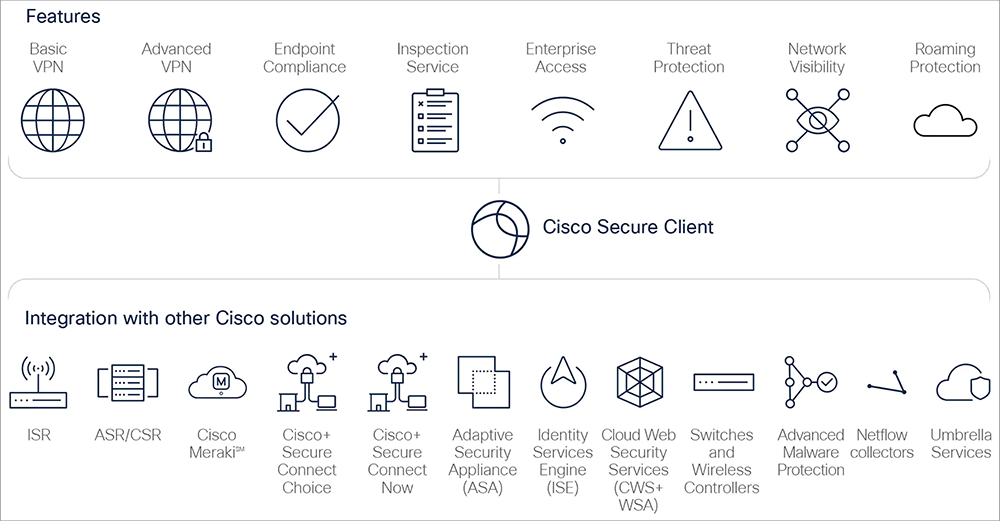
Documentation:
Download the Cisco Secure Client (including AnyConnect) Datasheet (PDF).
Download the Cisco Secure Client At-a-Glance (PDF).

